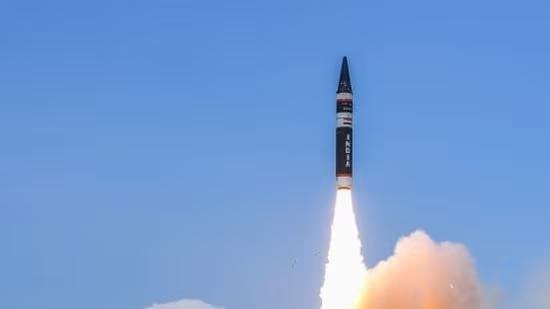India test-fires Agni-Prime missile from rail-based mobile launcher
- 30 Sep 2025
In News:
India has successfully test-fired the Agni-Prime (Agni-P) intermediate-range ballistic missile from a rail-based mobile launcher, marking a first-of-its-kind achievement in the nation’s defence history. The test was conducted from a platform integrated with the national railway network. This milestone represents a significant leap in India’s strategic mobility and deterrence capabilities.
About Agni-Prime Missile
- Type: Next-generation, nuclear-capable, intermediate-range ballistic missile (IRBM)
- Range: Up to 2,000 kilometres
- Developed by:Defence Research and Development Organisation (DRDO) in collaboration with the Strategic Forces Command (SFC)
- Part of: India’s Agni missile series, designed to reinforce the country’s credible minimum deterrence posture.
The Agni-Prime is equipped with advanced guidance and communication systems, featuring a canisterised launch mechanism that enhances storage safety, rapid deployment, and longer shelf life.
Rail-Based Mobile Launcher: A Game-Changing Innovation
The recent test marked the first time India used a rail-based canisterised mobile launcher.
- It can move seamlessly across the national rail network, allowing flexible positioning and quick deployment.
- The launcher enables a short reaction time with low visibility, enhancing operational stealth and survivability.
- This mobility reduces predictability of launch locations, complicating adversarial surveillance and targeting efforts.
Strategic Significance
- Enhanced Strategic Deterrence:The test demonstrates India’s ability to deliver a credible and survivable nuclear deterrent, joining the select group of nations with rail-based canisterised launch systems.
- Improved Survivability and Flexibility:Rail mobility adds a new dimension to India’s nuclear command structure by complementing road-based and silo-based systems, ensuring launch readiness even under high-threat scenarios.
- Operational Stealth and Rapid Response:The ability to launch within minutes from concealed rail positions strengthens India’s second-strike capability under its nuclear doctrine.
- Geopolitical Implications:The development aligns with India’s effort to maintain strategic stability in a complex regional environment, particularly amid evolving threats in South Asia and the Indo-Pacific.
Recent Developments in India’s Missile Programme
- In August 2025, Agni-Prime was successfully tested from Chandipur, Odisha.
- Earlier, in March 2024, under Mission Divyastra, India tested Agni-5 with MIRV (Multiple Independently Targetable Re-entry Vehicle) capability — allowing a single missile to carry and deliver multiple nuclear warheads to different targets.
- The Strategic Forces Command, operational since 2003, currently manages India’s nuclear arsenal and deployment systems.
Agni-Prime Ballistic Missile

- 05 Apr 2024
Why is it in the News?
India has successfully flight-tested the new generation ballistic missile Agni-Prime from the APJ Abdul Kalam Island off the coast of Odisha.
About Agni-Prime Missile:
- Agni-P or Agni-Prime is a new generation nuclear-capable medium-range ballistic missile (MRBM) developed by the DRDO that incorporates technological advances from Agni-IV and Agni-V and is considered a successor for Agni-I and Agni-II missiles in the operational service of the SFC.
- Agni-Prime, with a strike range of 1,000 to 2,000 km, has significant upgrades, which include composite motor casing, maneuverable reentry vehicle (MaRV), improved propellants, and navigation and guidance systems.
- It is a two-stage, surface-to-surface, road-mobile, and solid-fueled missile that is transported by a truck and launched via a canister.
- It is a ballistic missile with a dual redundant navigation and guidance system.
Features:
- Although Agni-Prime looks similar to Agni-III, the weight is reduced by half.
- Agni-P will replace older generation missiles such as Prithvi-II (350 km), Agni-II (2,000 km), Agni-III (3,000 km), and Agni-4 (4,000 km) ballistic missiles.
- Agni-Prime incorporates upgrades such as propulsion systems, composite rocket motor casings, and advanced navigation and guidance systems.
- Along with Agni-V, Agni-P will provide India with stronger deterrence against countries such as China and Pakistan.
- While Agni-V brings all of China within its strike range, Agni-P seems to have been developed to counter Pakistan's forces.
- Agni-P is developed to achieve maximum maneuverability against missile defense systems and higher accuracy for precision strikes.
What is a Ballistic Missile and why is it named so?
- A Ballistic missile follows a ballistic flight path - which comprises three phases of flight.
- In the first phase or the boost phase, the solid-fuel rocket engine propels the missile upwards and it has to rapidly gain velocity and altitude, by knifing through the densest parts of the earth's atmosphere.
- The second and unpowered phase of flight happens in the upper reaches of the earth's atmosphere or in space, where the missile travels along its pre-determined path, but without the power of its engines.
- It is known as the coast phase or mid-course phase and during this time, it travels along a horizontal path.
- During the coasting, the missile is either in space or the upper atmosphere, where it faces minimal resistance or drag.
- In the third and final phase or the terminal phase, the missile descends and gets back into the earth's atmosphere and flies towards its target, while being guided by its on-board systems.
